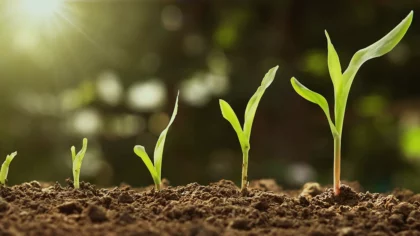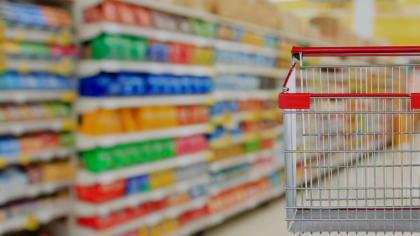Accelerate Productivity in 2025
Reignite Growth Despite the Global Slowdown
The beverage industry is changing in 2025 to align with consumer preferences, sustainability goals, and digital innovation. The global market is valued at USD 700.60 billion and is projected to grow at a CAGR of 7.94%. It will reach USD 1.02 trillion by 2030.
Companies are introducing low-ABV and non-alcoholic options, plant-based formulations, and functional beverages to match health-conscious demand. Meanwhile, digital-first models such as e-commerce and direct-to-consumer (DTC) are improving how brands engage with customers.
To remain competitive, manufacturers and retailers are adopting advanced technologies and circular practices that improve efficiency and reduce environmental impact.
What are the Top 10 Beverage Trends in 2025?
- eCommerce & DTC
- Automation and Robotics Integration
- Low-ABV & Non-alcoholic Beverages
- Plant-based Beverages
- Immersive Customer Experiences
- Generative AI
- IoT Integration
- Circular Economy
- Functional Drinks
- Blockchain Integration
Methodology: How We Created the Beverage Industry Trend Report
For our trend reports, we leverage our proprietary StartUs Insights Discovery Platform, covering 7M+ global startups, 20K technologies & trends, plus 150M+ patents, news articles, and market reports.
Creating a report involves approximately 40 hours of analysis. We evaluate our own startup data and complement these insights with external research, including industry reports, news articles, and market analyses. This process enables us to identify innovative and current trends in beverage industry.
For each trend, we select two exemplary startups that meet the following criteria:
- Relevance: Their product, technology, or solution aligns with the trend.
- Founding Year: Established between 2020 and 2025.
- Company Size: A maximum of 200 employees.
- Location: Specific geographic considerations.
This approach ensures our reports provide reliable, actionable insights into the beverage innovation ecosystem while highlighting startups driving technological advancements in the industry.
Innovation Map outlines the Top 10 Beverage Trends & 20 Promising Startups
For this in-depth research on the Top Beverage Trends & Startups, we analyzed a sample of 5700+ global startups & scaleups. The Beverage Innovation Map created from this data-driven research helps you improve strategic decision-making by giving you a comprehensive overview of the beverage industry trends & startups that impact your company.
Tree Map reveals the Impact of the Top 10 Beverage Trends
Consumer preferences and technology are reshaping the beverage industry. eCommerce and DTC channels strengthen brand-consumer relationships. Besides, immersive experiences improve digital engagement and loyalty.
Automation and robotics simplify production and packaging, with IoT integration enabling real-time monitoring and quality control. Further, generative AI supports product development and personalized marketing.
Circular economy initiatives and blockchain also improve sustainability and supply chain transparency. These advancements drive a shift toward efficient and responsible beverage ecosystems.
Global Startup Heat Map covers 5700+ Beverage Industry Startups & Scaleups
The Global Startup Heat Map showcases the distribution of 5700+ exemplary startups and scaleups analyzed using the StartUs Insights Discovery Platform. It highlights high startup activity in the US and India, followed by Canada. From these, 20 promising startups are featured below, selected based on factors like founding year, location, and funding.
Want to Explore Beverage Innovations & Trends?
Top 10 Emerging Beverage Trends [2025 and Beyond]
1. eCommerce & DTC
The rise of online shopping is changing how consumers purchase beverages. Convenience has become a lasting habit since the pandemic.
Gen Z and Millennials expect transparency in sourcing and sustainability. Brands use DTC channels to meet these demands and share ingredient origins and eco-friendly packaging.
E-commerce has lowered barriers to entry for beverage brands. Platforms like Shopify and fulfillment services such as ShipBob enable startups and established companies to scale DTC operations and bypass retail bottlenecks.
Major beverage companies incorporate DTC into their distribution strategies. PepsiCo invested USD 175 million in Instacart in 2023, and Coca-Cola backed Indian delivery startups Thrive and Zomato.
DTC-native brands demonstrate the model’s success. Liquid Death raised USD 67 million in March 2024 at a USD 1.4 billion valuation after generating USD 263 million in 2023 sales. Its growth was fueled by digital campaigns that resonated with younger audiences.
Further, Athletic Brewing leveraged DTC to reach consumers seeking non-alcoholic beer. Keurig Dr Pepper validated its model with a USD 50 million investment in 2023. Direct access allowed the brand to avoid shelf constraints and connect with health-conscious beer drinkers.
AI-driven personalization is reshaping online beverage retail. The 2024 State of Customer Service and CX Study found that 81% of consumers prefer personalized brand experiences. E.&J. Gallo Winery uses AI on its website to recommend wines based on customer behavior and preferences. It acts as a virtual sommelier.
Moreover, in 2023, US e-commerce beverage sales reached USD 9.9 billion, growing 15.2% year over year. Globally, the food and beverage e-commerce market is expected to reach USD 1481.29 billion by 2029 at an 18.5% CAGR.
Credit: The Business Research Company
Eighty6 offers Sales & Order Management SaaS
UAE-based startup Eighty6 develops an AI-driven SaaS platform that automates order management and sales for food and beverage distributors. It consolidates inputs from WhatsApp, email, and spreadsheets into a dashboard.
The platform includes a smart inbox that extracts structured order data from messages and documents for syncing it with ERP and invoicing systems. It supports online and offline modes, works across mobile and desktop, and provides real-time visibility into product availability, customer order history, and pricing.
The startup also provides additional tools that allow teams to push targeted promotions, clear expiring inventory, and segment campaigns by cuisine type or customer group.
Distributors use the platform to cut manual order entry, expand basket size, and improve order frequency through personalized promotions and CRM integration.
FIL Delivery provides Beverage 3PL
Canadian startup FIL Delivery offers third-party logistics for the beverage alcohol industry. It handles warehousing, distribution, and last-mile delivery.
The startup’s warehouse provides ambient and refrigerated storage. It supports pallet, case, and unit picking, as well as cross-packing and subscription fulfillment.
It offers a client portal MYFIL which allows users to gain real-time visibility into inventory, orders, and delivery status.
Its logistics team completes weekly deliveries across the province to serve LCBOs, on-premise licensees, grocery stores, convenience stores, and private residences.
FIL Delivery simplifies supply chains and enables wineries, breweries, distilleries, and agencies to scale within a regulated market.
2. Automation and Robotics Integration
Labor shortages are driving automation in the beverage sector. According to the 2024 Horizons: Digital Age of Food Manufacturing report, 78% of manufacturers use automation to address staffing challenges. Besides, 70% cite productivity gains as the primary benefit.
Credit: CRB
In March of last year, Coca-Cola Singapore and A*STAR introduced a robotic packing line that reduces manual tasks and enhances worker roles. The system includes smart vision detection and modular end-of-arm tooling for improving powdered ingredient packing with flexibility and precision.
Robotics is also advancing inspection operations. AB InBev deployed Boston Dynamics’ Spot robot in Leuven to support predictive maintenance and operational resilience. Continuous automated monitoring increases uptime and energy efficiency.
MCRI reported that 30% of its 2024 robotics project requests came from food and beverage firms. This growth reflects rising demand for automation in manufacturing and packaging.
Makr Shakr’s robotic bartender Nino customizes cocktails with AI. It enhances bar service with personalized drinks. AI-powered robotic baristas are also transforming coffee preparation to improve speed and consistency.
Moreover, the global beverage packaging machine market is projected to expand at a 6.5% CAGR through 2034. Companies are investing in higher-speed, flexible, and integrated packaging solutions.
Credit: Global Market Insights
Additionally, in the last year, the smart home beverage machine market exceeded USD 1.9 billion and is expected to grow at over 8.5% CAGR through 2034.
BevBridge makes a Cloud-based RFP Platform
US-based startup BevBridge develops a cloud-based RFP platform for the food and beverage industry. It digitizes the request-for-proposal process to improve efficiency and decision-making.
The startup allows users to create RFPs, invite suppliers, manage submissions, and finalize selections through a centralized interface. The platform enables company-wide portfolio sharing and detailed product requests by type, varietal, or price. Also, it offers real-time analytics to track campaign performance.
It captures data from emails and attachments and syncs information with built-in alerts, reminders, and collaboration tools to simplify approvals. Further, an asset and resource hub stores multimedia content and documentation, which allows businesses to expand sourcing and build stronger partner relationships.
BevBridge shortens RFP cycle times and improves compliance for operators, agencies, suppliers, and distributors.
Flying Turtle manufactures Robotic Barista
Australian startup Flying Turtle builds an AI-powered automated beverage machine that prepares various drink varieties within a compact 1-square-meter space. The system combines AI and precision robotics to mix and dispense smoothies, protein shakes, teas, and sodas.
It uses ingredients, including specialty coffee beans and internationally sourced cocoa. The machine also employs eco-friendly PLA bioplastic for cups, straws, and lids to reduce environmental impact
Flying Turtle provides a scalable, space-efficient beverage solution for high-traffic venues. Its automation enhances service while controlling labor costs.
3. Low-ABV & Non-alcoholic Beverages
According to NCSolutions’ 2024 consumer sentiment survey, 49% of US adults plan to reduce alcohol intake this year. This is a 44% increase since 2023.
Gen Z is leading this shift, with 65% intending to drink less and favoring beverages that support hydration, cognitive function, and stress relief.
Credit: NCSolutions
The World Health Organization (WHO) reported that by July 2022, 108 countries had implemented national sugar taxes on at least one type of sugar-sweetened beverage (SSB). Among them, 105 countries taxed sugar-sweetened carbonated drinks which encourages low-sugar and alcohol-free alternatives.
Alcohol-free socializing is becoming more common in the UK. GlobalData found that 45% of consumers regularly choose low-ABV options during festive seasons. It reflects the rise of the sober curious movement.
BevZero’s ClearAlc system aligns with this trend by using vacuum distillation to reduce alcohol content to 0.05% while maintaining flavor. The system also recovers 92% of ethanol for reuse and minimizes waste and thermal damage.
AI-driven fermentation enables beverage companies to refine flavor and mouthfeel in non-alcoholic beers. It replicates traditional IPA profiles without alcohol to enhance the sensory experience.
Asahi Europe & International (AEI) is growing its alcohol-free portfolio by aiming for 20% of product share by 2030. It recently introduced Peroni Nastro Azzurro 0.0% within its Super Premium lineup.
Further, Best Day Brewing, recognized as a fast-growing non-alcoholic craft beer brand in the US, announced USD 22.5 million in total funding in the last year. Its portfolio includes West Coast IPA, Hazy IPA, Kölsch, and rotating limited-edition flavors.
Moreover, Insights Ace Analytic estimates that the global low and no alcohol beverages market is projected to grow to USD 46.5 billion by 2034, with a CAGR of 6.2%.
Credit: Insight Ace Analytic
CROSSIP produces Non-Alcoholic Spirits
UK-based startup CROSSIP creates non-alcoholic spirits from raw botanical ingredients using a proprietary maceration technique that replicates traditional alcohol’s complexity and mouthfeel. Its product line includes Fresh Citrus, Pure Hibiscus, Dandy Smoke, Rich Berry, and Blazing Pineapple. Each of these drinks offers distinct flavor profiles from smoky and herbal to floral and tropical.
These beverages contain low sugar and fewer calories and cater to health-conscious consumers while maintaining a rich, adult-oriented taste. The startup curates over 140 cocktail and mixed drink recipes across seasonal and style categories. It enables bartenders and consumers to customize drinks for various occasions.
CROSSIP’s platform supports zero-proof and low-alcohol versions of highballs, spritzes, and classic cocktails such as sours, mules, and margaritas.
zeroLabs makes Non-Alcoholic Beer
German startup zeroLabs produces Unfiltered 0.0, a non-alcoholic, sugar-free beer. It uses four natural ingredients: Hallertauer hops, Pilsner malt, local spring water, and a proprietary single-use yeast strain.
The beer undergoes a six-week brewing process based on the traditional German Purity Law. Its extended fermentation and maturation build complexity, while vacuum distillation removes alcohol without affecting aroma compounds. This process ensures a true 0.0% ABV.
Its unfiltered finish maintains natural haze, body, and layered flavor without additives or sweeteners. zeroLabs creates a mild, full-flavored beverage that meets wellness and taste expectations.
4. Plant-based Beverages
Consumers view plant-based beverages as a healthier alternative to dairy, citing lower fat and cholesterol levels. This perception is driving demand for dairy-free options, especially among health-conscious groups.
Lactose intolerance further supports this shift. It remains widespread in Asia Pacific, where plant-based beverages serve as essential alternatives for digestive health and dietary comfort.
The rise in vegan and vegetarian diets also fuels demand. The World Animal Foundation reports that 6% of the US population identifies as vegan. This reflects a broader trend toward plant-based nutrition.
Further, technological advancements improve the quality and appeal of plant-based beverages. Enzymatic solutions from Amano Enzyme enhance extraction efficiency in coffee and tea to prevent precipitation and refine flavor for ensuring stability in mixed applications.
Preservation techniques strengthen product safety and shelf life. Hiperbaric’s high-pressure processing (HPP) applies 600 MPa of cold water pressure to inactivate pathogens without thermal degradation. This method maintains flavor, vitamins, and antioxidants while mimicking freshly squeezed juice.
Moreover, the global plant-based beverages market is expected to reach USD 88.72 billion by 2034, with a CAGR of 10.12% between 2025 and 2034.
Credit: Precedence Research
Oatey creates Oat Beverages
Indian startup Oatey produces plant-based milk alternatives from oats and millets. Its beverages provide a nutritious, dairy-free option for daily consumption.
The startup uses fiber-rich ingredients and clean-label formulations without added sugar, hormones, or preservatives. It blends these components to create a creamy texture suitable for various applications.
Further, Oatey sources low-erucic acid rapeseed oil and avoids synthetic additives to maintain natural sweetness. It offers vegan, lactose-free drinks that complement coffee, cereal, and smoothies without sacrificing taste or sustainability.
26 Group provides Plant-based Ingredients
US-based startup 26 Group supplies plant-based ingredients, including proteins, juices, purees, and IQF products, to industries such as food, beverage, and pharmaceuticals.
It processes juice concentrates by evaporating water from fruit extracts to create dense, storage-efficient forms for nectars, energy drinks, and cocktails. Its not-from-concentrate (NFC) juices retain the full flavor of the original fruit and serve as bases for premium beverages.
The startup also provides fruit and vegetable purees for dairy drinks, smoothies, and baby food. Its IQF products preserve freshness through rapid individual freezing.
5. Immersive Customer Experiences
Beverage brands are reshaping engagement through storytelling and multi-sensory experiences. Millennials and Gen Z prioritize emotional connections over material goods, which prompts companies to integrate taste, visuals, sound, and scent to create memorable interactions.
AR-enabled and interactive packaging provides a competitive advantage in retail while opening digital engagement channels. Besides, virtual bartending sessions and interactive storytelling add value beyond taste and appearance.
Ohio State University researchers developed e-Taste, a bio-integrated gustatory interface that analyzes molecular flavor profiles and recreates them using chemical infusions in a gel medium.
Virtual reality strengthens brand storytelling through immersive tours. Companies use VR to transport consumers to farms, vineyards, breweries, and factories. It highlights sourcing, sustainability, and production processes to build transparency and trust.
Wine brand 19 Crimes brings AR to its labels by animating historical figures who deliver monologues when scanned. This interactive feature adds depth to the brand experience and differentiates it in the wine aisle.
Further, WebAR eliminates the need for app downloads and improves accessibility. Jackson Family Wines’ Siduri brand used WebAR to animate its founder, who virtually steps out of the bottle to share brand stories and reinforce its playful identity.
Besides, the global immersive marketing industry is projected to grow at a CAGR of 28.6% from 2025 to 2030. Growth is fueled by advancements in VR headsets, AR glasses, and smartphone hardware that enable more realistic and interactive brand experiences.
Credit: Grand View Research
Take it izi provides an Immersive Shopping Experience
French startup Take it izi creates immersive virtual showrooms that blend physical retail with e-commerce convenience. It designs custom digital stores using 3D modeling and WebGL, which allows users to navigate freely, interact with products, and explore branded environments in detail.
The platform incorporates audiovisual content such as artisan interviews, manufacturing stages, and testimonials. These elements support informed decision-making and personalize the customer journey.
It also allows customers to visit virtual stores with friends or sales representatives. This creates real-time social interactions.
Designed for accessibility, the experience works across smartphones, tablets, PCs, and VR headsets. Take it izi combines visual immersion, interactivity, and human engagement to enhance digital retail.
Nitecapp offers On-premise Beverage Programming
US-based startup Nitecapp provides a digital training platform that allows hospitality staff to build product knowledge and improve guest service. It combines flashcards, quizzes, short-form videos, and an AI training assistant to support bartenders and servers in learning menus and refining beverage sales.
Through its Hospitality Dashboard, managers oversee staff training, update digital menus, and track real-time data across locations.
Beverage suppliers use the Beverage Dashboard to create certifiable courses, share brand content, and maintain consistent messaging through video-based education. The mobile-first platform supports intuitive onboarding and continuous skill development.
6. Generative AI
Generative AI is reshaping beverage development by simplifying product research and analysis. Carlsberg’s Beer Fingerprinting Project uses AI sensors to evaluate flavor profiles. It cuts down development time by 30% and improves formulation accuracy.
Packaging design is evolving with AI-driven tools like DALL·E and MidJourney. Brands use virtual prototyping to refine aesthetics, ergonomics, and sustainability. These simulations assess durability and visual appeal and enable companies to create recyclable packaging without physical trials.
Demand forecasting has also become more precise. PepsiCo uses AI models to analyze historical sales, weather patterns, and event data, predicting seasonal demand and optimizing production. This approach reduces waste and prevents stock shortages.
AI also enhances flavor innovation. Coca-Cola’s Y3000 flavor, a zero-sugar berry-cherry blend, emerged from AI analysis of global consumer preferences before human developers refined it.
Hell Energy applied similar AI-driven methods to align flavors with consumer expectations and EU food safety regulations. This resulted in its tutti-frutti & berry-blast drink.
Further, personalization is advancing through AI recommendation engines. Preferabli customizes wine suggestions using purchase history, wearable device data, and environmental factors like weather. The Vine & Cellar Reserve experience offers guided recommendations, detailed flavor profiles, and food pairing advice.
Additionally, the global generative AI in the CPG market is expected to reach USD 5.4 billion by 2033, expanding at a CAGR of 9.5% from 2024 to 2033.
Credit: market.us
exhive builds Generative AI for Beverage Manufacturing
Finnish startup exhive develops a generative AI platform that speeds up product development in the food and beverage industry. It generates optimized recipes within defined constraints to reduce reliance on physical prototypes.
The platform centralizes formulation data, ingredient specifications, sensory attributes, and process parameters for refining products efficiently. Developers set targets for taste, texture, cost, or functional performance, and the system generates recipe variations that meet regulatory and claim requirements.
Its built-in feedback loop captures structured sensory and analytical evaluations to improve future recipe iterations. It allows users to track all project data from concept to consumer response within a single interface for ensuring traceability and optimization.
MenuData offers Menu Trends & Insights
US-based startup MenuData makes an AI-driven insights platform for food and beverage businesses. It monitors emerging trends, supports innovation, and strengthens market strategies.
The platform aggregates data from over 300 000 restaurant menus, 20 million retail SKUs, and social media channels to identify trending flavors, menu items, and consumer preferences.
Generative AI processes this data to provide real-time insights for product development, sales strategies, and marketing intelligence.
Distributors use MenuData to pinpoint upselling opportunities and align recipe ingredients with product SKUs. Moreover, manufacturers rely on the platform for new product design and market positioning.
Further, operators simplify menu development, track competitors, and target flavor innovations for specific demographics and locations.
7. IoT Integration
Beverage companies are using IoT to improve sustainability and efficiency. Heineken partnered with Siemens to simulate a brewery with an energy digital twin. It revealed that heating and cooling account for 70% of energy use. Optimizing these systems could lower energy consumption by 15-20% and cut CO₂ emissions by 50%.
Regulatory standards for quality and traceability are driving IoT adoption. Sensors track temperature, humidity, and other variables to ensure consistent product quality and compliance with food safety requirements.
IoT also reduce waste. Collo’s liquid analyzers prevent dairy loss during production. A mid-sized plant without inline monitoring could lose up to 8 million liters of milk annually. IoT solutions conserve 11 million kg of CO₂ and 35 million liters of water while preserving valuable products.
Additionally, companies are testing IoT-enabled packaging for transparency and customer engagement. NFC smart tags on premium liquor bottles verify authenticity and deliver branded content through smartphones to strengthen consumer trust.
Brazilian startup Enjoy introduced a self-service beer tap system with IoT flow sensors for bars and stadiums. Customers pour precise quantities, and the system tracks volume and charges automatically for improving service and reducing waste.
Market projections estimate that the IoT and traceability for the food and beverage manufacturing sector will reach USD 35.69 billion by 2031, growing at a CAGR of 9.78% from 2024 to 2031.
Credit: Verified Market Research
Indeex makes Digital Twin for F&B
Greek startup Indeex develops a digital twin software that upgrades food and beverage manufacturing systems without hardware changes. It connects with industrial protocols like Modbus TCP and OPC-UA to extract real-time data from PLCs, SCADA systems, and standalone machines. It turns each component into a virtual IoT device.
The platform organizes this data into time series, which enables anomaly detection, automated reporting, and digital copies for repeatable processes such as CIP and packaging. It tracks KPIs at the batch level, compares results with historical data and user-defined standards, and provides insights to reduce inefficiencies, minimize losses, and improve asset utilization.
With embedded analytics and production benchmarking, Indeex strengthens traceability, supports proactive scheduling, and simplifies operational supervision. It integrates with beverage, dairy, and packaging plants and enables businesses to improve productivity, sustainability, and cost efficiency.
Chill it builds Cooling Systems
Mexican startup Chill it offers rapid beverage cooling systems that provide energy-efficient chilling for cans, PET bottles, and wine. Its Artica unit lowers drink temperatures to -1°C in 30 seconds using thermal transfer technology.
The startup’s Wine unit cools beverages to 15°C, 12°C, or 7°C to preserve the ideal serving temperature for red, rosé, and white wines.
Both devices reduce the need for continuous refrigeration, cut energy consumption, and use less polyurethane than traditional coolers.
Artica offers customizable branding, EAN-based beverage recognition, and real-time connectivity for monitoring and remote updates. Wine supports re-chilling opened bottles and enables by-the-glass service with a universal cork system to maintain quality and minimize waste.
8. Circular Economy
Governments are implementing regulations to promote circularity in beverage packaging. The EU’s Packaging and Packaging Waste Regulation (PPWR), agreed upon in 2023, requires all member states to introduce deposit-return schemes for bottles and cans by 2029. It also mandates that 10% of beverages be sold in reusable packaging formats by 2030.
Consumers support these initiatives. Matter Communications’ 2024 Food & Beverage Trends survey found that 41% of consumers prioritize sustainable packaging over other sustainability efforts.
Circular practices provide economic benefits. Coca-Cola HBC reports that local recycled PET production secures a steady, high-quality supply of bottle material to reduce transport needs and minimize exposure to raw material market fluctuations.
The Sustainable Packaging Coalition notes that material recovery facilities now use AI-powered robots and optical sorters to identify packaging types with precision. These tools enhance recovery rates and produce cleaner, higher-value materials for preventing bottles and cans from ending up in landfills.
Digital tools support closed-loop systems. Connected packaging with QR codes, RFID tags, or digital watermarks, such as those in the HolyGrail 2.0 initiative, improves sorting accuracy.
Companies are also testing refillable containers, app-enabled returns, and smart dispensers that collect used bottles or serve beverages in reusable cups.
Further, packaging R&D is shifting away from plastic. Paperization is gaining momentum, with WestRock and Atlantic Packaging developing Canopy, a fiber-based wrap designed to replace plastic shrink films for bulk beverage cans. These advancements promote recyclability and reduce plastic waste.
The global circular economy market for the beverage industry is expected to expand at a CAGR of 6.8% from 2025 to 2034.
Credit: Insight Ace Analytic
Circea enables Upcycling Biogenic CO2
Swiss startup Circea builds carbon capture and reuse systems that convert biogenic CO₂ emissions from fermentation and biogas upgrading into inputs for agri-food and chemical industries. It installs modular piping on fermentation tanks and biogas units in breweries and vineyards to recover, dehydrate, purify, and compress CO₂ for storage.
The captured CO₂ is reused onsite or distributed to nearby partners for strengthening local supply chains and reducing reliance on fossil-derived CO₂.
Circea runs pilot projects for biogas purification and incorporates CO₂ recovery into biomethane production. It reduces industrial waste, supports decarbonization, and promotes regional defossilization through circular carbon ecosystems.
Loopedin advances Reusable Packaging
Singaporean startup Loopedin develops a closed-loop reusable packaging platform for the food and beverage industry. It replaces single-use containers with durable, RFID-enabled, food-grade polypropylene units.
The platform integrates smart dispensing machines and reverse collection stations into client operations. Customers scan QR codes to access reusable containers and return them for automated cleaning, restocking, and reuse.
Its asset management system tracks container usage, supports ESG reporting, and encourages consumer participation through digital engagement tools. All containers are BPA-free, customizable, dishwasher-safe, and microwave-safe to ensure durability over multiple use cycles.
9. Functional Drinks
Consumers are choosing beverages that support overall health for addressing hydration, energy, digestion, immunity, and emotional well-being. This shift has grown post-pandemic, increasing demand for drinks enriched with vitamins, antioxidants, and probiotics.
NIQ data shows that 77% of consumers avoid brands engaged in greenwashing, which emphasizes the importance of ingredient transparency and verified health claims.
Millennials and Gen Z are driving the functional beverage market with a focus on self-care and mental wellness. Social media trends, such as “gut health” and nootropic coffee challenges, fuel experimentation.
Meanwhile, aging consumers seek drinks designed for longevity, muscle strength, and bone health, including protein- and calcium-enhanced options.
Beverages are increasingly used to manage stress, fatigue, and focus. Online searches reflect growing interest in solutions for low energy and mood issues. This increases demand for nootropic drinks that enhance mental clarity and adaptogenic beverages that support anxiety and sleep. Brands now include ingredients like ashwagandha, L-theanine, ginseng, and magnesium to improve emotional balance and cognitive function.
Adaptogens and functional mushrooms are becoming more common. Herbs such as rhodiola and mushrooms like reishi, lion’s mane, and cordyceps are now included in drink formulations for stress relief and brain health.
Gut health remains a priority in functional drink development. Products feature probiotics and prebiotics that support immunity and digestion. In Japan, Coca-Cola’s Plus cola contains dextrin fiber to reduce fat absorption.
Other functional ingredients, such as collagen peptides for skin, turmeric for inflammation, and matcha blended with chamomile show growing consumer interest in natural bioactives.
Besides, taste remains a key factor in purchase decisions. Mintel’s 2023 US Functional Drinks Market Report found that 43% of consumers prioritize flavor over function when selecting beverages.
To meet this demand, brands enhance formulations with natural sweeteners and fruit infusions to balance herbal notes. New formats such as sparkling tonics, health shots, powders, and functional cold brews, such as STōK’s ginseng- and B-vitamin-infused coffee, cater to evolving tastes and consumption habits.
Further, the functional beverages market is projected to reach USD 174.12 billion by 2030, growing at a CAGR of 4.86% between 2025 and 2030.
Credit: Research and Markets
Bear Maple crafts Functional Sparkling Ginseng
US-based startup Bear Maple creates a sparkling adaptogenic tonic that blends hydroponically grown Panax ginseng with forest-harvested maple water. The beverage provides natural sweetness without caffeine to support focus, immunity, and stress management.
The startup steeps whole ginseng roots to preserve beneficial ginsenosides like Rg3 and Rk1. Its lightly carbonated blends Yuzu Citrus, Lemongrass Mint, and Ginger Citrus contain fewer than 10 calories and no artificial sweeteners.
Bear Maple uses BPA-free, GMO-free, and pesticide-free ingredients to ensure traceability and minimize environmental impact. It provides a wellness-focused option that supports health and environmental responsibility.
Innerbloom makes Functional Cold Brew Coffee
New Zealand-based startup Innerbloom creates functional cold brew coffee beverages that blend organic coffee with L-theanine. The formulation provides sustained energy, improves focus, and reduces caffeine-related side effects.
The startup brews its coffee from organically grown beans and supports climate-friendly agriculture. L-theanine, an amino acid derived from green tea, counteracts caffeine jitters and crashes, to promote a calm, focused state.
Innerbloom’s product line includes variants with protein, oat milk, maca root, and MCT oil to support physical performance and overall wellness.
10. Blockchain Integration
The EU’s Deforestation Regulation requires proof that commodities like coffee and cocoa are not sourced from deforested land. This rule mandates tamper-proof supply chain records.
Blockchain allows for meeting this requirement by creating verifiable logs of sourcing and production to ensure compliance and transparency.
IBM Institute for Business Value reports that 73% of consumers are willing to pay more for full product transparency. Blockchain platforms provide detailed, real-time data on each bottle’s origin and production to securely share information across the supply chain with authorized stakeholders.
IBM Food Trust, built on Hyperledger Fabric, is a major blockchain network for food and beverage traceability. It supports millions of transactions and tracks thousands of products for clients such as Walmart, Dole, and Nestlé. Ethereum and its Layer-2 networks enable consumer-facing applications, including Coca-Cola’s NFT-linked product authenticity verification.
Specialized blockchain platforms are gaining adoption in supply chain traceability. VeChain’s ToolChain verifies wine and spirits authenticity in Asia, while Cardano supports Georgia’s national wine traceability initiative.
Further, AB InBev tested blockchain with 20 000 barley growers to integrate QR codes on beer packs like Leffe. French consumers are able to scan these codes to trace the barley’s origin to specific farms in Belgium to strengthen transparency in the product journey.
Starbucks introduced a blockchain traceability tool. Customers scan codes on coffee bags to track beans from farms in Colombia, Rwanda, and Costa Rica through roasting and retail stages.
Besides, counterfeit alcohol remains a concern. In the EU, fake wine and spirits result in estimated losses of EUR 1.3 billion annually. Beverage makers counter this risk with blockchain-based digital passports that verify authenticity and prevent fraud.
TRACEWINDU, an EU-funded consortium launched this year, assigns unique blockchain identities to wine bottles using chemical fingerprints of the terroir. Each step from vineyard to bottling is immutably recorded. QR-coded smart tags enable consumers to verify provenance and vintage.
Moreover, the global blockchain market for supply chain traceability is expected to reach USD 44.3 billion by 2034, expanding at a CAGR of 31.40% from 2025 to 2034.
Credit: market.us
Spydra enables Dairy Supply Chain Tokenization
Indian startup Spydra develops a blockchain-based asset tokenization platform that digitizes dairy supply chains. It converts physical assets, including cattle, raw milk, and finished products, into secure, traceable tokens.
Credit: Spydra
The platform enables decentralized data entry and real-time updates by integrating with existing systems. It invites all supply chain participants to the blockchain network to ensure accurate and transparent transactions. Through Oracle-integrated IoT devices, it monitors environmental conditions such as temperature and triggers automated alerts for incidents.
Spydra’s Workflow engine automates payments to farmers based on event milestones, including quality checks. Its analytics dashboard tracks SKUs and products to improve logistics and recall efficiency.
The startup enables processors to enhance traceability and compliance, retailers to access real-time inventory data, and consumers to verify product origin and quality.
GLASS creates Brand Engagement Platform
US-based startup GLASS develops a SaaS engagement platform that allows food and beverage brands to strengthen consumer relationships. It captures and rewards behavior across in-store, online, and social interactions.
The platform uses receipt scanning, image upload challenges, and smart dispensing integrations to collect first-party data from purchases, events, and sampling activations. It supports cross-channel loyalty programs that offer gift cards, branded merchandise, and experiential rewards. This drives e-commerce traffic and consumer referrals.
Brands onboard users at retail stores, sponsored events, and social occasions, which turns campaigns into ongoing interactions.
Discover all Beverage Trends, Technologies & Startups
Emerging technologies and shifting consumer values are reshaping the beverage sector. Personalized nutrition platforms, digital twins for production facilities, and AI-driven flavor design are gaining traction.
Further, sustainability remains a priority. Water-efficient brewing systems and biodegradable packaging are becoming essential for long-term environmental impact reduction.
The Beverage Industry Trends & Startups outlined in this report only scratch the surface of trends that we identified during our data-driven innovation & startup scouting process. Identifying new opportunities & emerging technologies to implement into your business goes a long way in gaining a competitive advantage.
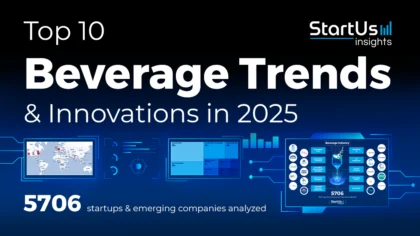

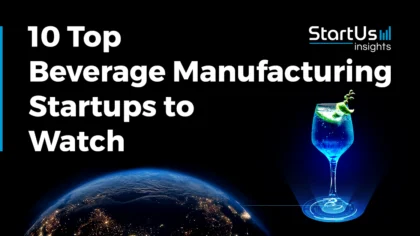
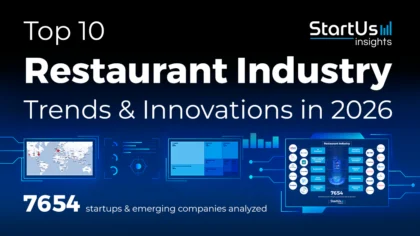
![7 Top 3D Food Printing Companies and Startups to Watch [2026]](https://www.startus-insights.com/wp-content/uploads/2025/08/3D-Food-Printing-Startups-SharedImg-StartUs-Insights-noresize-420x236.webp)


